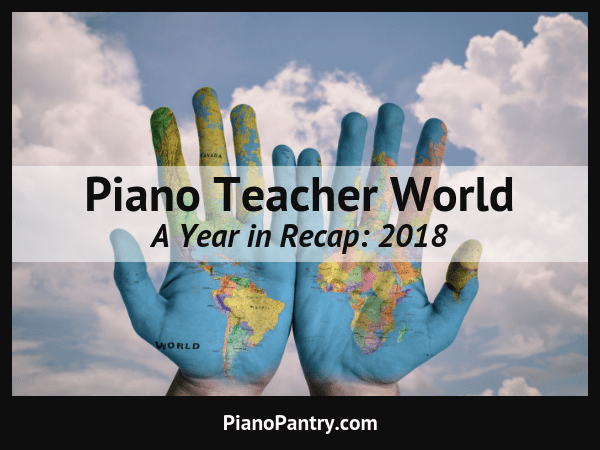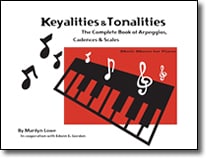
Last year (2017), after being inspired by a post written by Leila Viss in 2016, I decided to sit down and think through everything that happened not only in my world as an independent piano teacher but just in general in what I would call “Piano Teacher World”.
Writing posts like these the last couple of years have been very enlightening, encouraging and really just a healthy exercise in gratitude in general.
The idea behind the “Piano Teacher World” recap is to take a look back at significant news, happenings, and impact in the world of independent piano teachers. The final part of this post also includes resources that have made a direct impact on my own teaching.
I tried to be as thorough as I could and will admit that the list is much smaller than it was last year. Be sure and share in the comments if there was anything you would add to the list!
For the sake of being thorough, I asked for recommendations on multiple Facebook groups and received a lot of excellent feedback on The Art of Piano Pedagogy group regarding overall trends – all of which I agree with. Let’s start with those. (If you’re interested in reading all the comments, which are much more specific, check out the full post here.)
2018 Trends
1 | Declining or leveled-off interest in iPads and apps. Better balance and understanding in the role they play in lessons.
2 | Teaching and learning piano online is becoming more and more viable and easily available.
3 | A shift in attitude and growing excitement toward rote teaching/learning.
4 | Increased curiosity and interest in Music Learning Theory and how it can impact piano teaching, not just Early Childhood Music.
5 | Continually improved quality and ease-of-availability in regards to self-published material.
6 | Rising interested in quality blogs, podcasts, and online communities.
7| Continual professionalization of the field.
8 | A renewed interest in pedagogy outside of academia.
9 | Ongoing concerns with declining membership in professional organizations such as MTNA.
Also mentioned in the list, while not a “trend,” was Brenda Wristen and Lora Deahl’s book Adaptive Strategies for Small-Handed Pianists (Published November 2017).
In Piano Teacher News
ELISA MILNE opened a shop on her website.
Launch of CYBER CONSERVATORY that accompanies the app Super Score.
A teacher friend shared this one specifically with me. She has always loved Marvin Blickenstaff’s method “Music Pathways” and Paul Sheftel’s MIDI accompaniment for the series. She says there are lots of good compositions by Lynn Freeman Olson.
THE FRANCIS CLARK CENTER is continuing to see changes as Dr. Pamela Pike was named the new Editor in Chief/Chief Content Director and Dr. Andrea McAlister was appointed as the new Director of Content Curation and Senior Editor for Clavier Companion.

They also launched a Facebook group for subscribers called Piano Teach Learn.
GDPR made everyone freak out and go crazy with emails and notices, tripling the communication in our inboxes.
MTNA (Music Teacher National Association will hold its first online video competition for the division performance competitions.
NATALIE WEBER relaunched her Music Matters Blog with a fresh new look.
Weber was one of the first piano teacher bloggers to impact “Piano-Teacher-World” as her first post went up in September 2005.
PIANO PANTRY started the new monthly “Secret Letter,” which is the main line of communication to subscribers. The letter is not available anywhere online, including social media. We also hit Friday Finds #100 in mid-June.
PIANO SAFARI released the 2nd Edition of Repertoire Book 1, Repertoire Book 2, and Technique Book 2.
They also launched their new series Piano Safari for the Older Beginner.
In My Own Little Corner of P.T. World
New Pageant’s for Piano

While it’s been in my files for several years, the value and quality of Donald Waxman’s New Pageants for Piano has finally hit me.
Unique in its philosophy, Waxman has written a “method” of pieces that introduce students to sounds beyond that of major and minor. The award-winning art adds to the visual appeal and helps invoke students’ imagination.
Tonic: The Card & Dice Game
Tonic: The Card & Dice Game for Musicians is a game to inspire improvisation and was first introduced to many of us by Joy Morin.
Most of my students are older and beyond a lot of the beginner music theory games I have in my studio, so we haven’t been doing a lot of games in our lessons this year. The one game I have been pulling out, though, is this one, and, for some students especially, it has been a favorite.
If you want to see one of my students playing this game, visit this post on Facebook.
Keyalities and Tonalities: The Complete Book of Arpeggios, Cadences & Scales
Like Donald Waxman’s book mentioned above, it has taken me a few years to really appreciate (and become comfortable) with Marilyn Lowe’s Keyalities & Tonalities book.
From the website: “Organized by keyality, this book is an encyclopedia for students to help in mastering all major and minor keyalities. Other tonalities are represented by identifying the characteristic tone, melodic cadence, and harmonic cadence for each tonality (or mode).”
While I don’t use this book directly with all my students, it has inspired some of the new pattern work I have been integrating into all my student’s lessons this semester. (Someday, I hope to share more specifics.)
What had the biggest impact on you this past year? Comment below!





